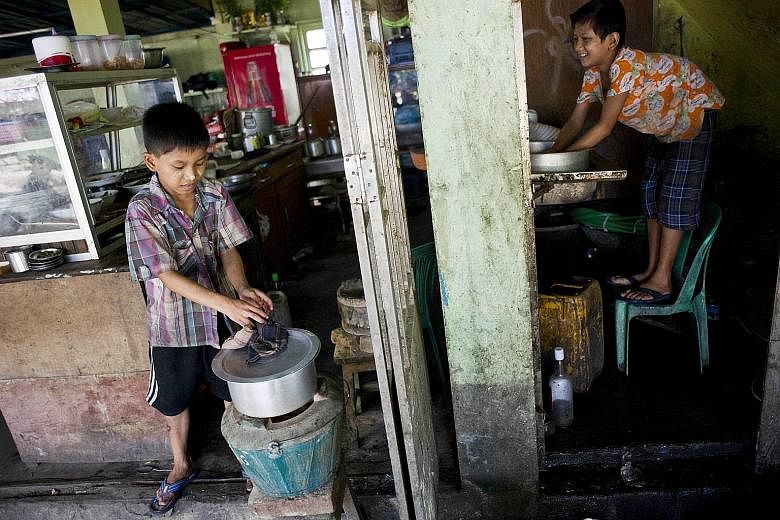YANGON • Twelve-year-old Myat Noe dashes between tables, taking orders and sweeping up cigarette butts for around US$1 (S$1.39) a day in Myanmar, which has one of the worst records for child labour in the world.
There are millions like Myat Noe - child workers are widely accepted in the former junta-ruled nation - who prop up everything from tea rooms to factories. But pressure is building for a change of attitude and law.
Weeks away from the Nov 8 election, a coalition of campaign groups are seizing the opportunity for debate, and urging lawmakers to provide universal, compulsory and free education within five years. Ms Aung San Suu Kyi's National League for Democracy is expected to make major gains in the election, and has identified education as the cornerstone in reducing poverty but, so far, has not committed to this demand.
A quick glance along Yangon's streets reveals that there is some way to go. Roadside tea shops - busy jumbles of plastic tables and chairs usually patronised by chain-smoking men - are mostly staffed by children, some as young as seven years old.
"I come from the countryside and I have to help my parents, because they don't have enough money," said Myat Noe, whose name has been changed to protect her identity. Like many child workers , she comes from one of Myanmar's poor ethnic minority groups and has worked since she was nine.
Child workers often toil 14 hours a day, seven days a week, sleeping in large dormitories with other children or on the plastic tables which they wait on by day.
According to data from the 2014 census, Myat Noe is one of an estimated 4.4 million under-18s who do not attend school in Myanmar.
The impoverished country is the world's seventh worst for child labour, according to risk analysts Verisk Maplecroft, just ahead of India and Liberia. The rate looks set to rise as the economy booms four years after opening up to the world, with new hotels, cafes and factories providing jobs to willing workers, irrespective of age.
A tangle of labour laws do not ban children from work, said Ms Piyamal Pichaiwongse of the International Labour Organisation (ILO) in Yangon. "There is nothing clear on the age at which you can start work, and the laws are not applied," she said.
In 2013, Myanmar joined an ILO convention which outlaws the worst forms of child labour, such as forced work, including in the army or sex industry. The government said it wants to address the situation but, until a binding law is crafted, children will remain ever-present in the workforce.
In an attempt to reach working children, several organisations provide free schooling on the job.
Three nights a week for the last six months, 15-year-old Naing Lin Aung has attended class after a full day working the tea shop tables.
"I don't know what will happen to me in the future so I want to learn some English, some computer skills, some knowledge of health, in case I get sick," he said, his eyes red with fatigue.
The Myanmar Mobile Education project (myME) helps 600 children in Yangon and Mandalay by holding classes in tea shops after closing time. For those working at 24-hour joints, it runs an improvised classroom in a minibus.
To Mr Tim Aye-Hardy, founder of myME, a generation is being sacrificed because of poverty. "What kind of jobs will they get, what kind of future is open for them and for the country?"
AGENCE FRANCE-PRESSE

